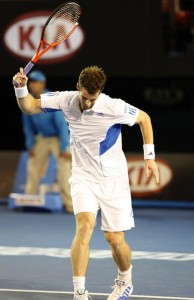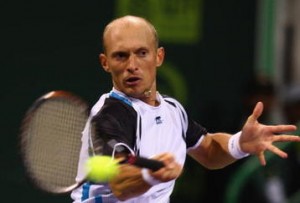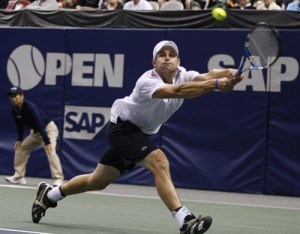Men’s Tennis Power Rankings: Can Anyone Catch Roger Federer?
Just as 2009 ended with Roger Federer atop both the ATP rankings and the Power Rankings, so it is after the first month of the 2010 season. With eight ATP tournaments and the opening Grand Slam in Australia now complete, there’s a certain déjà vu feel to proceedings, with Federer reasserting his dominance in the Majors with his 16th Slam title.
Thereafter, things have started to take on a slightly different look in both sets of rankings, starting at No. 2, where Andy Murray has gained ground at the expense of the injury-blighted Rafael Nadal.
Below them, a couple of the big men who imposed themselves on the top 10 last year, Fernando Verdasco and Robin Soderling, have lost ground to the fast-improving Marin Cilic and the slow-maturing Jo-Wilfried Tsonga.
So there’s much to play for as the Tour heads towards the bigger rewards of the 500 point tournaments in February and the first Masters events in March (more on that later).
For an explanation of the formula for devising these Power Rankings, please check out Feng Rong’s original article.
The Top 10
1. Roger Federer (Last Power Ranking, 5: ATP Ranking, 1)
Last Four Tournaments: Australian Open [Winner], Doha [Semifinalist], London [Semifinalist], Paris [R32]
Power Ranking Points: 1055
Federer won his first Australian title since 2007 in convincing style, with the loss of just two sets in the whole tournament. Particularly noteworthy was his quarterfinal win over end-of-year champion and Doha victor, Nikolay Davydenko, who had beaten Federer at both those events.
Federer’s decisive win against Murray in the Australian final also re-established his superiority over a player claiming a superior head-to-head record. Not only has Federer now won their last three matches, but he has twice beaten Murray in straight sets in Grand Slam finals.
More than 300 points clear of the field, Federer can put on more points in Doha (which he missed last year with injury), and keep alive the Sampras target of 286 weeks at No. 1. In his current form, who would bet against him also targeting the calendar Slam?

Andy Murray's Australian Open ended in frustration, but he had a great tournament.
2. Andy Murray (Last Power Ranking, 4: ATP Ranking, 3)
Last Four Tournaments: Australian Open [Finalist], London [RR (2-1)], Paris [R16], Valencia [Winner]
Power Ranking Points: 682
The pressure for Murray to win a Major continues. Having reached his second Grand Slam final, he once more encountered an in-form Federer at the last hurdle. Up to that point, he’d dropped just one set, to Cilic in the semis, and produced some stunning tennis to hold off a blistering attack from Nadal.
It was enough to move Murray ahead of Nadal in the ATP rankings. With neither of them playing in Rotterdam, where Murray beat Nadal in the finals in 2009, those positions can be reversed next week, so Murray will want to perform well in Dubai to reclaim the No. 3 spot. Only problem is, Federer is back in the draw in the desert this year.
3. Marin Cilic (Last Power Ranking, NR: ATP Ranking, 10)
Last Four Tournaments: Zagreb [Winner], Australian Open [Semifinalist], Chennai [Winner], Paris [Quarterfinalist]
Power Ranking Points: 675
Much has been expected of the tall and talented Croatian, and that promise has certainly flowered this year. Cilic has put together a formidable run, including wins over Juan Martin del Potro and Andy Roddick before succumbing to Murray in Melbourne, and titles in Chennai and in Zagreb.
Last year, Cilic faded as the Tour moved towards the Masters events, but his growing fitness and confidence could see him build on his newly-won entry into the ATP top 10.
Still only 21, he may be the del Potro of 2010.
4. Jo-Wilfried Tsonga (Last Power Ranking, NR: ATP Ranking, 9)
Last Four Tournaments: Australian Open [Semifinalist], Paris [Quarterfinalist], Valencia [R32], Lyon [Quarterfinalist]
Power Ranking Points: 378
A slim-line Tsonga showed amazing speed, form, and consistency in reaching the semifinals in Melbourne, his best showing since winning in Tokyo last autumn. His focused handling of Novak Djokovic in the quarters from a two-sets-to-one deficit was a good sign from the exciting, but often frustrating, Frenchman. Two demanding five-setters on the trot weighed heavy when it came to playing Federer in the semis, though.
His schedule so far this year has been trimmed down from 2009, and he did not defend his title in Johannesburg this week. He has now withdrawn from Rotterdam, citing a ‘trunk injury.’ It will be an anxious wait to see whether he defends his Marseille title next week.

Nikolay Davydenko
5. Nikolay Davydenko (Last Power Ranking, 1: ATP Ranking, 6)
Last Four Tournaments: Australian Open [Quarterfinalist], Doha [Winner], London [Winner], Paris [R16]
Power Ranking Points: 356
All eyes were on the diminutive Russian when the draw was made for Melbourne, and the prospect of a quarterfinal meeting with Federer, who he’d beaten twice in as many meetings, was one of the picks of the tournament.
With wins over both Federer and Nadal under his belt in Doha, his confidence blossomed in Melbourne, and a witty character emerged alongside a string of convincing results.
Despite taking a first set from Federer, he could not maintain the pressure over the five-set format, so still has to prove himself capable of winning a Slam. This might have been his best chance, but if he maintains his form through the coming weeks, he could well grab another Masters title for his trophy cupboard this spring.
6. Novak Djokovic (Last Power Ranking, 2: ATP Ranking, 2)
Last Four Tournaments: Australian Open [Quarterfinalist], London [RR (2-1)], Paris [Winner], Basel [Winner]
Power Ranking Points: 338
Djokovic made a strong showing in the autumn indoor season, but the tiredness was showing by the end of the year. So it made sense for Djokovic to opt out of the pre-Australian events. So much was expected from him in Melbourne, especially with the relatively temperate conditions this year. He seemed to be a fitter player than a year ago, yet he faded physically against Tsonga in one of those now-familiar Djokovic moments—and a near repeat of his exit at the same stage last year.
This continues to be a real concern for his Majors career, though his ATP performances should ensure he maintains his highest ever ranking (No. 2) for a while yet.
7. Rafael Nadal (Last Power Ranking, 8: ATP Ranking, 4)
Last Four Tournaments: Australian Open [Quarterfinalist], Doha [Finalist], London [RR (0-3)], Paris [Semifinalist]
Power Ranking Points: 240
Things looked pretty positive for Nadal coming into Melbourne. He was beaten by an on-fire Davydenko in the Doha final and advanced to the predicted quarterfinal against Murray. It proved to be an exciting match, but Nadal struggled to keep up with Murray’s all-court firepower the longer it went on.
Hearts sank when Nadal had to retire with knee trouble, though it appears to be a less chronic problem than last year’s tendinitis. So it’s more time away until, probably, Indian Wells where, as titleholder, Nadal has points to defend. Until then, he should hold on to his No. 4 ranking—his lowest position in the almost five years.

Andy Roddick will look to make a move after reaching the quarterfinals of the Australian Open.
8. Andy Roddick (Last Power Ranking, NR: ATP Ranking, 7)
Last Four Tournaments: Australian Open [Quarterfinalist], Brisbane [Winner], Shanghai [R32], Beijing [R32]
Power Ranking Points: 231
All credit to Andy Roddick. His Melbourne quarterfinal marked his 18th career Grand Slam quarterfinal, and his win the week before in Brisbane was his 28th singles title. Only Federer and Nadal have more among active players.
Considering how poorly his 2009 concluded—sidelined by a knee injury since Shanghai—Roddick’s season has started well. He is still ambitious for a Slam victory, believing Wimbledon to be his best hope. If dedication and hard work have anything to do with it, who’s to say that’s not possible?
9. Gael Monfils (Last Power Ranking, 7: ATP Ranking, 13)
Last Four Tournaments: Johannesburg [Semifinalist], Australian Open [R32], Brisbane [Semifinalist], Paris [Finalist]
Power Ranking Points: 203
Monfils seems constantly bent upon teasing his many fans by edging towards the top 10 (which he just managed to do early last year), only to drift back a few places.
He tends to perform well in front of his home crowd—he made the final at the Paris Masters—but singularly fails to score wins over other top 10 players—he managed it against Roddick at Roland Garros last year.
If Monfils could only match his concentration to his extraordinary athleticism and shot-making, he may appear in both the Power and the ATP rankings with a regularity more commensurate with his talent.
10. Juan Martin del Potro (Last Power Ranking, 3: ATP Ranking, 5)
Last Four Tournaments: Australian Open [R16], London [Finalist], Paris [Quarterfinalist], Shanghai [R32]
Power Ranking Points: 178
Since his success in reaching the year-end finals, del Potro has maintained a low profile and a quiet schedule. His first ATP outing is not until Marseille next week, which may help him work back to his best form in time for the first Masters events.
Del Potro’s fourth round Australian encounter gave him a taste of the challenge he now faces, in the form of another 6’6” 21-year-old making his way into the elite: Cilic. Their next meeting will be very interesting indeed, and it could be at Dubai, where six of the top 10 men will be competing.
Outside Looking In
John Isner (Last Power Ranking, NR: ATP Ranking, 25)
Last Four Tournaments: Australian Open [R16], Auckland [Winner], Paris [R32], Basel [R16]
Power Ranking Points: 160
The towering American continues to make his presence felt since his brief appearance in the Power Rankings during the U.S. Open. He began 2010 by winning his first ATP title in New Zealand, and took out Monfils in Melbourne before losing to Murray.
His declared target at the start of the year was to break the top 20. With a jump of more than 100 places in 2009 (despite having a bout of mono in the middle of the year), and already up nine places to 25 this year, that looks well within his reach.
Marcos Baghdatis (Last Power Ranking, NR: ATP Ranking, 36)
Last Four Tournaments: Australian Open [R32], Sydney [Winner], Brisbane [R16], Stockholm [Winner]
Power Ranking Points: 128
With two tournaments already in his legs before Melbourne, including the title in one of them, Baghdatis struggled to complete a four-hour marathon against David Ferrer. Fighting through cramp to win that second round match, he then had to retire against Lleyton Hewitt in the third round.
Baghdatis should come back rested to Rotterdam this week and will need to be if he’s to build on his good results at the end of 2009. He faces James Blake in first round, only to face Davydenko in the second. He has few points to defend in the coming weeks so, if he maintains fitness, who could still continue to climb the ATP rankings.
Fernando Verdasco (Last Power Ranking, 10: ATP Ranking, 11)
Last Four Tournaments: Australian Open [R16], London [RR (0-3)], Paris [R16], Valencia [Semifinalist]
Power Ranking Points: 111
The powerful Spaniard seems, for the moment at least, to have hit a brick wall. He made it through to the WTFs by the skin of his teeth after a real break-through last year, but how much more can he improve?
With his fitness and power game now near their best (though there have been a few niggling injuries of late), he needs to find some variety to give himself more options when playing the top dozen men. Perhaps he has fulfilled his potential—which is an achievement in itself. The next couple of weeks, as he opens his ATP account, could mark a significant point in his year.
Author’s Thoughts
Points won and lost in the run up to the first big Masters events of the year can make a significant difference to certain sections of the rankings. Indian Wells and Miami have draws of 96, and extended seedings to match. And being seeded can make the difference between, for example, meeting Federer in the first round or the third.
Currently, there are more than 3000 points between Federer and second ranked Djokovic. That’s about the same as between No. 2 and No. 6. But between No. 10 and No. 20, there are only around 1200 points.
So if Verdasco gets good results in San Jose and Memphis in the next couple of weeks, he could enter the top eight. Cilic could do the same. And as a result, they would avoid the top men before the quarterfinals.
Further down the draw, Feliciano Lopez, who has just won in Johannesburg, could move into a seeded position if he goes deep into the 500 events in Rotterdam and Dubai.
The four February 500 tournaments can, therefore, make a whole lot of difference to a whole range of players ahead of those two big North American Masters in March.
Click here for the current Women’s Tennis Rankings.










